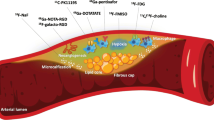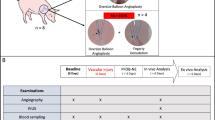Abstract
The presence of activated macrophages is an important predictor of atherosclerotic plaque rupture. In this study, our aim was to determine the accuracy of 18F- fluorodeoxyglucose (FDG) microPET imaging for quantifying aortic wall macrophage content in a rabbit model of atherosclerosis. Rabbits were divided into a control group and two groups post aortic balloon injury: 6 months high-cholesterol diet (HC); and 3 months HC followed by 3 months low-cholesterol diet plus statin (LCS). In vivo and ex vivo microPET, ex vivo well counting and histological quantification of the atherosclerotic aortas were performed for all groups. Macrophage density was greater in the HC group than the LCS group (5.1 ± 1.4% vs. 0.6 ± 0.7%, P < 0.001) with a trend towards greater macrophage density in LCS compared to controls (P = 0.08). There was a strong correlation across all groups between macrophage density and standardized uptake value (SUV) derived from ex vivo microPET (r = 0.95, P < 0.001) and well counting (r = 0.96, P < 0.001). Ex vivo FDG SUV was significantly different between the three groups (P < 0.001). However, the correlation between in vivo microPET FDG SUV and macrophage density was insignificant (r = 0.16, P = 0.57) with no statistical differences in FDG SUV seen between the three groups. This study confirms that in an animal model of inflamed and non-inflamed atherosclerosis, significant differences in FDG SUV allow differentiation of highly inflamed atherosclerotic aortas from those stabilized by statin therapy and low cholesterol diet and controls.







Similar content being viewed by others
References
Virmani R, Burke AP, Farb A, Kolodgie FD (2006) Pathology of the vulnerable plaque. J Am Coll Cardiol 47:C13–C18
Davies MJ, Thomas AC (1985) Plaque fissuring—the cause of acute myocardial infarction, sudden ischaemic death, and crescendo angina. Br Heart J 53:363–373
Ben-Haim S, Kupzov E, Tamir A, Israel O (2004) Evaluation of 18F-FDG uptake and arterial wall calcifications using 18F-FDG PET/CT. J Nucl Med 45:1816–1821
Rudd JHF, Warburton EA, Fryer TD, Jones HA, Clark JC, Antoun N, Johnstrom P, Davenport AP, Kirkpatrick PJ, Arch BN, Pickard JD, Weissberg PL (2002) Imaging atherosclerotic plaque inflammation with 18F-fluorodeoxyglucose positron emission tomography. Circulation 105:2708–2711
Davies JR, Rudd JHF, Fryer TD, Graves MJ, Clark JC, Kirkpatrick PJ, Gillard JH, Warburton EA, Weissberg PL (2005) Identification of culprit lesions after transient ischemic attack by combined 18F-fluorodeoxyglucose positron-emission tomography and high-resolution magnetic resonance imaging. Stroke 36:2642–2647
Okane K, Ibaraki M, Toyoshima H, Sugawara S, Takahashi K, Miura S, Shimosegawa E, Kitamur J, Satoh T (2006) 18F-FDG accumulation in atherosclerosis: use of CT and MR co-registration of thoracic and carotid arteries. Eur J Nucl Med Mol Imaging 33:589–594
Tawakol A, Migrino RQ, Bashian GG, Bedri S, Vermylen D, Cury RC, Yates D, LaMuraglia GM, Furie K, Houser S, Gewirtz H, Muller JE, Brady TJ, Fischman AJ (2006) In vivo 18F-Fluorodeoxyglucose positron emission tomography imaging provides a noninvasive measure of carotid plaque inflammation in patients. J Am Coll Cardiol 48:1818–1824
Dunphy MP, Schoder H, Strauss HW (2007) Radionuclide techniques for identifying vulnerable plaque. J Nucl Med 48:1753–1755
Dunphy MP, Freiman A, Larson SM, Strauss HW (2005) Association of vascular 18F-FDG uptake with vascular calcification. J Nucl Med 46:1278–1284
Silvera SS, Aidi HE, Rudd JH, Mani V, Yang L, Farkouh M, Fuster V, Fayad ZA (2009) Multimodality imaging of atherosclerotic plaque activity and composition using FDG-PET/CT and MRI in carotid and femoral arteries. Atherosclerosis. doi:10.1016/j.atherosclerosis.2009.04.023
Rudd JH, Hyafil F, Fayad ZA (2009) Inflammation imaging in atherosclerosis. Arterioscler Thromb Vasc Biol 29:1009–1016
Lederman RJ, Raylman RR, Fisher SJ, Kison PV, San H, Nabel EG, Wahl RL (2001) Detection of atherosclerosis using a novel positron-sensitive probe and 18-fluorodeoxyglucose (FDG). Nucl Med Commun 22:747–753
Ogawa M, Ishino S, Mukai T, Asano D, Teramoto N, Watabe H, Kudomi N, Shiomi M, Magata Y, Iida H, Saji H (2004) 18F-FDG accumulation in athorosclerotic plaques: immunohistochemical and PET imaging study. J Nucl Med 45:1245–1250
Ogawa M, Magata Y, Kato T, Hatano K, Ishino S, Mukai T, Shiomi M, Ito K, Saji H (2006) Application of 18F-FDG PET for monitoring the therapeutic effect of antiiflammatory drugs on stabilization of vulnerable atherosclerotic plaques. J Nucl Med 47:1845–1850
Tawakol A, Migrino RQ, Hoffmann U, Abbara S, Houser S, Gewirtz H, Muller JE, Brady TJ, Fischman AJ (2005) Noninvasive in vivo measurement of vascular inflammation with F-18 fluorodeoxyglucose positron emission tomography. J Nucl Cardiol 12:294–301
Zhang Z, Machac J, Helft G, Worthley SG, Tang C, Zaman AG, Rodriguez OJ, Buchsbaum MS, Fuster V, Badimon JJ (2006) Non-invasive imaging of atherosclerotic plaque macrophage in a rabbit model with F-18 FDG PET: a histopathological correlation. BMC Nucl Med 6:4
Izquierdo-Garcia D, Davies JR, Graves MJ, Rudd JH, Gillard JH, Weissberg PL, Fryer TD, Warburton EA (2009) Comparison of methods for magnetic resonance-guided [18-F]fluorodeoxyglucose positron emission tomography in human carotid arteries. Reproducibility, partial volume correction, and correlation between methods. Stroke 40:86–93
Rudd JH, Myers KS, Bansilal S, Machac J, Pinto CA, Tong C, Rafique A, Hargeaves R, Farkouh M, Fuster V, Fayad ZA (2008) Atherosclerosis inflammation imaging with 18F-FDG PET: carotid, iliac, and femoral uptake reproducibility, quantification methods, and recommendations. J Nucl Med 49:871–878
Rudd JH, Myers KS, Bansilal S, Machac J, Rafique A, Farkouh M, Fuster V, Fayad ZA (2007) 18Fluorodeoxyglucose positron emission tomography imaging of atherosclerotic plaque inflammation is highly reproducible: implications for atherosclerosis therapy trials. J Am Coll Cardiol 50:892–896
Fischman AJ, Lees AM, Lees RS, Barlai-Kovach M, Strauss HW (1987) Accumulation of native and methylated low density lipoproteins by healing rabbit arterial wall. Arteriosclerosis 7:361–366
Kinahan PE, Rogers JG (1989) Analytic 3D image reconstruction using all detected events. IEEE Trans Nucl Sci 36:964–968
Patlak CS, Blasberg RG (1985) Graphical evaluation of blood-to-brain transfer constants from multiple-time uptake data. Generalizations. J Cereb Blood Flow Metab 5:584–590
Lehr HA, van der Loos CM, Teeling P, Gown AM (1999) Complete chromogen separation and analysis in double immunohistochemical stains using Photoshop-based image analysis. J Histochem Cytochem 47:119–126
Acknowledgments
This study was funded by programme grants from the British Heart Foundation. JRD, DI-G, JHFR, JLEB, APD, and PLW are all supported by grants from the British Heart Foundation (FG/03/013 and PS/02/001). EAW receives support from the Cambridge Biomedical Research Centre grant (NIHR). This work was also supported by an equipment grant (microPET) from the HEFCE and Merck Sharp and Dohme, Ltd. We would like to acknowledge the Wolfson Brain Imaging Centre radiochemistry staff for supplying the FDG.
Author information
Authors and Affiliations
Corresponding author
Additional information
The authors John R. Davies and David Izquierdo-Garcia have contributed equally to the study.
Rights and permissions
About this article
Cite this article
Davies, J.R., Izquierdo-Garcia, D., Rudd, J.H.F. et al. FDG–PET can distinguish inflamed from non-inflamed plaque in an animal model of atherosclerosis. Int J Cardiovasc Imaging 26, 41–48 (2010). https://doi.org/10.1007/s10554-009-9506-6
Received:
Accepted:
Published:
Issue Date:
DOI: https://doi.org/10.1007/s10554-009-9506-6




